
The fiddler crab or calling crab may be any of more than one hundred species of semiterrestrial marine crabs in the family Ocypodidae, well known for their sexually dimorphic claws; the males' major claw is much larger than the minor claw, while the females' claws are both the same size. A smaller number of ghost crab and mangrove crab species are also found in the family Ocypodidae. This entire group is composed of small crabs, the largest being slightly over two inches (5 cm) across. Fiddler crabs are found along sea beaches and brackish intertidal mud flats, lagoons, swamps, and various other types of brackish or salt-water wetlands.
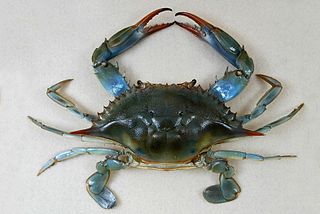
Callinectes sapidus, the blue crab, Atlantic blue crab, or, reigonally, the Maryland blue crab, is a species of crab native to the waters of the western Atlantic Ocean and the Gulf of Mexico, and introduced internationally.

Porcelain crabs are decapod crustaceans in the widespread family Porcellanidae, which superficially resemble true crabs. They have flattened bodies as an adaptation for living in rock crevices. They are delicate, readily losing limbs when attacked, and use their large claws for maintaining territories. They first appeared in the Tithonian age of the Late Jurassic epoch, 145–152 million years ago.
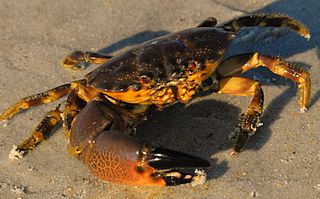
The Florida stone crab is a crab found in the western North Atlantic, from Connecticut to Colombia, including Texas, the Gulf of Mexico, Belize, Mexico, Jamaica, Cuba, The Bahamas, and the East Coast of the United States. The crab can also be found in and around the salt marshes of South Carolina and Georgia. It is widely caught for food. The closely related species Menippe adina is sometimes considered a subspecies – they can interbreed, forming hybrids – and they are treated as one species for commercial fishing, with their ranges partly overlapping. The two species are believed to have diverged approximately 3 million years ago.

Callinectes is a genus of crabs, containing 16 extant species, including the Atlantic blue crab, C. sapidus:

The Jonah crab is a marine brachyuran crab that inhabits waters along the east coast of North America from Newfoundland to Florida. Jonah crabs possess a rounded, rough-edged carapace with small light spots, and robust claws with dark brown-black tips. The maximum reported carapace width for males is 222 mm, while females rarely exceed 150 mm. It is the closest relative to the European brown crab in the Western Atlantic.
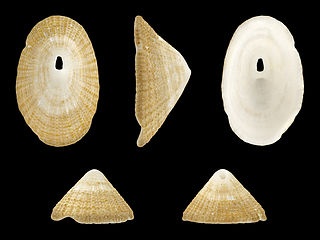
Diodora cayenensis, the Cayenne keyhole limpet, is a species of small to medium-sized sea snail or limpet, a western Atlantic marine prosobranch gastropod mollusk in the family Fissurellidae, the keyhole limpets.

Menippidae is a family of crabs of the order Decapoda.
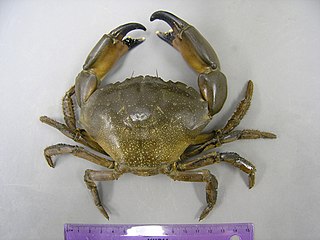
Menippe adina is a species of crab, sometimes called the Gulf stone crab or Western Gulf stone crab. It is very closely related to the Florida stone crab, Menippe mercenaria, of which it is sometimes considered to be a subspecies.

Callinectes similis, sometimes called the lesser blue crab or dwarf crab, is a West Atlantic species of blue crab. It was described by Austin B. Williams in 1966.

The Atlantic ghost crab, Ocypode quadrata, is a species of ghost crab. It is a common species along the Atlantic coast of the United States, where it is the only species of ghost crab; its range of distribution extends from its northernmost reach on beaches in Westport, Massachusetts, south along the coasts of the tropical Western Atlantic Ocean to the beach of Barra do Chui, in Rio Grande do Sul in southern Brazil.
M. mercenaria may refer to:
Melybia thalamita is a species of crab in the family Xanthidae, the only species in the genus Melybia. It is found in the western Atlantic Ocean, from Florida and the Gulf of Mexico south to São Paulo, Brazil, at depths of 10–200 metres (33–656 ft).
Pinnixa chaetopterana, the tube pea crab, is a small decapod crustacean that lives harmlessly within the tube of the polychaete worm, Chaetopterus variopedatus.

Emerita analoga, the Pacific sand crab, Pacific mole crab or coldwater mole crab, is a species of small, sand-burrowing decapod crustacean found living in the sand along the temperate western coasts of North and South America. It is found on exposed sandy beaches in the swash region of the intertidal zone.

The Panopeidae are a family containing 26 genera of morphologically similar crabs, often known as "mud crabs". Their centers of diversity are the Atlantic Ocean and eastern Pacific Ocean.

Dyspanopeus sayi is a species of mud crab that is native to the Atlantic coast of North America. It has also become established outside its native range, living in Swansea Docks since 1960, the Mediterranean Sea since the 1970s, the North Sea since 2007 and the Black Sea since 2010. It can reach a carapace width of 20 mm (0.8 in), and has black tips to its unequal claws. It feeds on bivalves and barnacles, and is in turn eaten by predators including the Atlantic blue crab, Callinectes sapidus. Eggs are produced from spring to autumn, the offspring reach sexual maturity the following summer, and individuals can live for up to two years. The closest relative of D. sayi is D. texanus, which lives in the Gulf of Mexico; the two species differ in subtle features of the genitalia and the last pair of walking legs.
Declawing of crabs is the process whereby one or both claws of a crab are manually detached before the return of the live crab to the water, as practiced in the fishing industry worldwide. Crabs commonly have the ability to regenerate lost limbs after a period of time, and thus declawing is viewed as a potentially more sustainable method of fishing. Due to the time it takes for a crab to regrow lost limbs, however, whether or not the practice represents truly sustainable fishing is still a point of scientific inquiry, and the ethics of declawing are also subject to debates over pain in crustaceans.

Moreiradromia antillensis is a species of decapods in the family sponge crab. This species lives in the Western and central Atlantic Ocean.
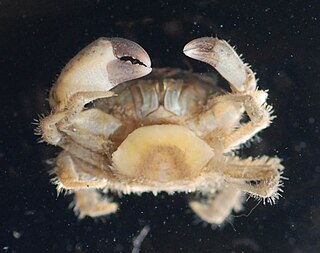
Loxothylacus panopaei is a species of barnacle in the family Sacculinidae. It is native to the Gulf of Mexico and the Caribbean Sea. It is a parasitic castrator of small mud crabs in the family Panopeidae, mostly in the Gulf of Mexico, the Caribbean Sea and the eastern Atlantic Ocean.















